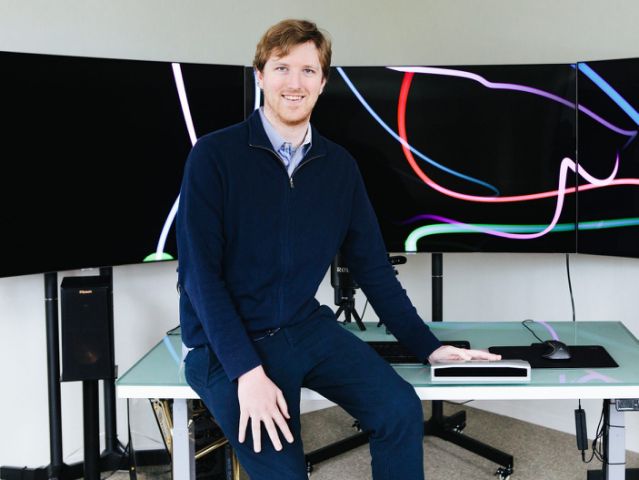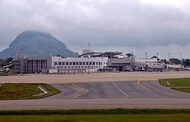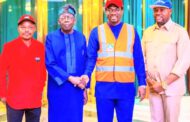On December 3, pink confetti rained down upon yet another tech entrepreneur. Decked out in his own interpretation of CEO casual – a navy zip-up jacket over a button-down, dark jeans, and matching sneakers – the 6-foot-plus Austin Russell towered over the Nasdaq platform in Times Square, clapping and nodding as he rang the opening bell.
He was on the mostly empty trading floor for the virtual IPO ceremony for Luminar, the self-driving-car tech startup that Russell founded at 17, eight years ago. Self-studying and tinkering as a teen put Russell, now 25, on the path to dominate autonomous cars, thanks to breakthroughs he made with lidar sensors.
Russell’s rise reads like a Silicon Valley myth. He was hacking at lidar – an innovative way for cars to see the world in his self-made garage lab in 2012, years before the importance of lidar became clear. Today Luminar’s 350 employees operate out of a 50,000-square-foot manufacturing facility at its Orlando, Florida, headquarters and a converted tank-repair facility in Palo Alto, California.
He took Luminar public in December through a reverse merger with the special-purpose acquisition company (SPAC) Gores Metropoulos. Four days after the initial public offering, shares of Luminar Technologies jumped as much as 25%, extending a three-day gain of more than 110% to $41.80 per share.
The stock has been somewhat volatile since, retreating nearly 50% at one point to $22.87, and trading around $30 as of Friday’s close. During the mid-December trench in the stock’s value, the short-selling firm Citron advised against buying Luminar stock in a tweet, while one analyst has a hold rating on it. (Two other analysts have a buy rating on it.) Still, Russell has vaulted into historic, generational wealth.

Russell is now the youngest self-made billionaire and one of just a dozen living people to become a self-made billionaire before 30, according to Forbes. He owns about one-third of Luminar’s outstanding equity and had an estimated net worth of $3.2 billion as of January 17.
On a Zoom call from a wood-paneled room, Russell told me a few weeks after the IPO that he was more excited about the “creation curve” in his career: “It’s exciting to be among the Zuckerbergs of this world who have really built out something incredible early on.”
Zuckerberg became a billionaire at 23 thanks to Facebook. At the time, his net worth was $1.1 billion; today it’s $100.2 billion. Evan Spiegel and Bobby Murphy of Snapchat previously held the youngest-billionaire title with $1.5 billion each at the time; Russell topped that with a $2.4 billion net worth when he hit the three-comma club. Imagine what all this means for Russell, who had the richest fortune of the 10 people who became billionaires as 20-somethings.
An outlier among outliers, Russell caught disruptive tech innovation in an emerging industry at an unprecedented young age, with wealth creation accelerated by a novel financial process.
Here’s what it takes to become the youngest billionaire.
Doomed to fail?
Luminar isn’t without its critics. Tesla CEO Elon Musk has criticized lidar sensors for years, saying they’re too expensive for consumer cars. “Anyone relying on lidar is doomed,” Musk said at Tesla’s 2019 Autonomy Day.
The technology was developed in 1960. Lidar, whose name combines the words light and radar, could unlock the large-scale adoption of self-driving cars.
Lidar sensors emit pulses of light, helping self-driving cars perceive the road by measuring how long the light takes to bounce back after hitting an object. Imagine if your eyes were able to detect the amount of time it took between turning on a flashlight and seeing an object reflected in its beam while providing a detailed map highlighting the size and position objects in the world around you – that’s what happens when a vehicle’s lidar sensors send out light that bounces back. Luminar also makes software and other hardware components for driver-assistance programs.

But to Russell, Musk has no choice but to denounce lidar because Tesla is already committed to a different technology.
“The hard part is that if you make huge promises to folks with existing hardware setups, you kind of back yourself into a corner,” Russell said.
Tesla did not respond to requests for comment.
Russell operated Luminar in secrecy with cofounder Jason Eichenholz from 2012 to 2017, when it emerged from stealth mode, powered by venture funds. Within a year, Luminar had added 200 employees and created a new system that it said could cut the cost of a key component in its lidar from thousands of dollars to just $3.
Lidar can often cost tens of thousands of dollars, but this cost cutting helped Luminar introduce in 2019 a relatively thrifty Iris lidar system starting at a subscription-price point of $1,000 for autonomous applications and $500 for applications in advanced driver-assistance systems. And Russell added that if many people shared Musk’s sentiment, Luminar wouldn’t have been able to sign three production deals in 2020: with Volvo to include the Iris sensors on its cars beginning in 2022, with Daimler to produce autonomous trucks, and with Mobileye to supply lidar units in the first generation of Mobileye’s driverless fleet.
‘An information sponge’
Russell, identifiable by his thick, light ginger hair, talks quickly and confidently but in a way that’s more knowledgeable than cocky. It’s easy to tell he’s housing a lot of info in his brain.
He wasn’t born into a tech-savvy household – his father worked in commercial real estate, and his mother dabbled in modeling and public speaking – but one could say Luminar was in Russell’s blood.

His paternal great-grandfather, S.I. Russell, invented the modern-day electric blanket, and his maternal grandfather, Rudy Cleye, built a raceway.
Russell stacked up his inventor’s résumé early on. He memorized the periodic table of elements at 2, worked as a software consultant by 10, and filed his first patent at 13, which was for a water-recycling system.
As a teenager, Russell mostly lived out of the makeshift electronics and optics lab he set up in his parents’ garage in Newport Beach in Southern California, he said. Surrounded by his self-built supercomputer, he studied hardware systems and later optics and photonics.
When his parents wouldn’t let him get a cellphone, Russell built his own using a Nintendo DS, he told The Orange County Register. He also built a holographic keyboard system, a cancerous-mole laser detector, and developed long-distance wireless power-transmission systems.
“The kid’s mind is so broad that he literally always had 50 ideas going at one time,” Tony Jordan, his physics teacher at St. Margaret’s Episcopal School in San Juan Capistrano, told Bloomberg in 2017.
The impulse to learn has carried over to his adult life: Russell said he skimmed through 1,000 articles or papers a day. “I’ve always had a lot of curiosity, wanting to understand the ways of how things work, asking way too many questions, just being an information sponge,” Russell said. “I had that bug to always want to build and create early on.”
I had that bug to always want to build and create early on.
He said his parents would joke: “You just go do your black magic in the lab; we’ll slip food under the door.”
Rather than “doing the day-to-day stuff” of high school, Russell said he spent more time in his garage lab and working as an independent researcher at the Beckman Laser Institute of the University of California, Irvine.
After high school, he went off to study physics at Stanford but dropped out six months later to continue his work on Luminar after receiving the prestigious Thiel Fellowship, the startup accelerator created by the Silicon Valley entrepreneur and venture capitalist Peter Thiel that pays students $100,000 to drop out of school and build a startup for two years.
Russell said he always knew academia wasn’t for him.
He said too many technologies get developed without an application or end up stuck in the lab. He’d followed what the autonomous-vehicle industry was doing with lidar sensors and was determined to find a way to make an affordable version that could be universal.
“It’s very hard to have an appreciable impact on the world with just an idea if you can’t build an economic engine behind it to actually have it have real world application,” he said.
A quiet beginning
In Luminar’s earliest days, Russell built a Silicon Valley hacker-house network, or a coliving space for entrepreneurs. He found himself working among other “smart folks” he could vet as future Luminar employees. The benefits were twofold, he said: It was the most cost-effective way for him to start building a lab, as well as a side business to help finance it.
Russell eventually hired engineers and scaled things up, but he was in no rush.

“There’s a reason we’ve been in stealth so long,” Russell told Insider in 2017, the year the company finally started facing the public. At the time, it had raised $36 million from venture capitalists including GVA Capital, Canvas Ventures, and the 1517 Fund, a venture firm backed by Thiel. “If we announced our plans five years ago, everybody would be doing this,” he said.
Innovation for Russell meant having patience to build a better lidar system that would advance an industry while saving lives. At the time, he said the company had tried 2,000 ways to construct a lidar system before deciding on a functional one that could be manufactured.
Russell eschewed traditional lidar designs and built a new one on a different wavelength and with the chemical compound indium gallium arsenide instead of the typical silicon – more powerful but still safe for eyes. Luminar says its system provides a full seven seconds for a self-driving system to react to an object 250 meters away, longer than its competitors.
Luminar’s lidar breakthroughs are a result of Russell’s unique mindset. He thinks broadly from the bottom up while disregarding the norms of conventional thought, Jun Hong Heng of Crescent Cove Advisors, one of Luminar’s earliest investors, told Insider. According to him, Russell begins his thought process by asking seemingly mundane questions and challenges traditional thinking by asking why things need to be done a certain way.
“Not only is he thinking ‘outside the box,’ Austin is completely discarding the ‘box,'” he said.
A pandemic IPO
When I asked Russell to sum up what it took to be Luminar’s CEO in three qualities, he thought before answering for so long that I thought our Zoom meeting had frozen.
Eventually, he replied: a deep technical understanding, a passion for safety and autonomy, and a relentless desire to win. It also means a lack of sleep; Russell estimates he works 80 to 120 hours a week, saying Saturday mornings are when he’s in his Zen mode. It’s not enough for Russell to just develop the right and best technology; he needs to see through on its implementation until he’s achieved his vision of ending automobile accidents.
For the past year or two, going public had been on Russell’s mind, he said. But the timing wasn’t quite right. That all changed in May, when both Russell and the auto industry hit an important milestone. The deal with Volvo to use Luminar’s lidar in vehicles as part of its advanced driver-assistance system, beginning in 2022, was the first instance of an automaker committing to equip its production vehicles with lidar sensors. (Mercedes-Benz and BMW also have plans to add lidar.)
A Volvo spokesperson told Insider that Luminar “is a clear leader” in lidar and perception technology. “The technology is what Volvo needs to introduce safe autonomous drive to its customers on its next generation platform.”

Russell told Insider in August, when Luminar announced its SPAC deal, that he felt a reverse merger was more appealing than a traditional IPO because it offered more certainty around the money Luminar could raise and the valuation it could receive. It also helped that financial markets had recovered, reverse mergers had become more popular, and Gores – the SPAC Luminar merged with – had tech and automotive expertise, he added.
With a reverse merger, a private company has to negotiate a sale price only with the SPAC, though institutional investors may also pitch in. Gores raised $400 million, and a group of investors including Thiel, Volvo Cars Tech Fund, and VectoIQ raised an additional $170 million, Insider’s Mark Matousek reported.
Russell said he thought the concept of SPAC IPOs was here to stay.
“It enables you to be able to tap into the public markets and establish a smoother, more sensical approach generally than a traditional IPO, and much more quickly,” he said. “I think it’s the future of IPOs.”
The road ahead
But like many high-tech startups, Luminar has been unprofitable. Its revenue increased by nearly $1 million to $12.6 million in 2019, but it lost $94.7 million, according to a Securities and Exchange Commission filing. The autonomous-vehicle industry is still in the early research and development stage, and Luminar doesn’t expect to be profitable until at least 2022, when the Volvo production deal starts. It’s poised to create at least $1.3 billion by 2026, according to SEC filing estimates.
The R&D stage means that Luminar also has no real track record of manufacturing at scale with other orders on the line, though Luminar outsources its series-production manufacturing using its own manufacturing “blueprint,” which it says allows it to scale on demand in a de-risked capacity.
Its competitor Velodyne also went public via SPAC merger, and the lidar startup Aeva plans to do the same. Tristan Gerra, a senior analyst at Robert W. Baird, said he anticipated more companies would come to the lidar space, with consolidation following. Luminar say it’s banking on recent lidar companies seizing opportunities in adjacent industries as it realizes the challenges to exiting the R&D stage.
Luminar could also find itself caught between high-end lidar technologies and the mass-volume market, which is dominated by Velodyne, Gerra, who put a hold on buying or selling Luminar stock, said. Velodyne’s total addressable market will likely be larger since it also targets nonautomotive applications, Gerra said, while Luminar is focused solely on automotive. Velodyne forecast $101 million in revenue for 2020, compared with Luminar’s $15.2 million.

In a best-case scenario, Luminar could dominate the high end of the lidar market and become “the de-facto vendor,” Gerra said.
Russell believes Luminar is capable of doing just that, proved by a lidar system that’s both higher-performing and more affordable than legacy systems and that made Luminar the first to win a series-production deal for autonomy.
Deutsche Bank said it expected Luminar to become a leader in lidar solutions with a total addressable market of $40 billion by 2030.
“Luminar is one of the only available automotive-grade lidar solutions with good enough performance to enable highway-speed vehicle autonomy at an acceptable cost,” Emmanuel Rosner, the lead US auto and auto-technology analyst at Deutsche Bank who put a buy on Luminar stock, told Insider. “Many competing solutions either offer shorter perception range or won’t be ready for production before several more years.”
That is all to say: Luminar’s eight-year progress and tech breakthroughs indicate a promising future, but it’s still relatively early on. Whether Russell’s billionaire status sticks will depend on Luminar’s continued performance.
Now that Luminar is public, Russell is focused on one thing: execution.
“We have everything lined up for us: the technology, the economics, the financial backing, the business, the estimated $1.3 billion order book that we have to deliver against,” he said. “What’s left to do is execute.”
Read the original article on Business Insider














